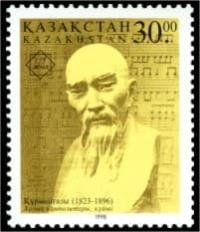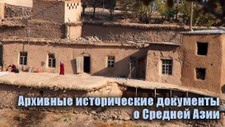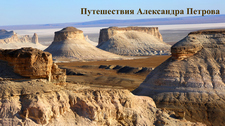Вы здесь
Kurmangazy Sagyrbai uly.

Outstanding composers of Kazakhstan.
"I was surprised at first, and then amazed by his playing. I never expected that something resembling music could come out of such a poor primitive instrument with two strings, but such is the power of human ability - and the purest music came out of the dombra, although the character of the melody was Kyrgyz, but depending on how it is expressed, it can be placed alongside works of exemplary music, because Sagyrbaiyev's playing comes from the same source - gift and inspiration."
Memories of Ural journalist Nikita Savichev about Kurmangazy Sagyrbai uly.Newspaper "Uralskiye voyskovye vedomosti", article "From Karmanovsky outpost to Glininsky". October 27, 1868. In article N. Savichev indicates that he met Kurmangazy in house of Cossack I.F. Borodin in September 1868.
Silk Road from Shymkent to Tashkent.
Kurmangazy Sagyrbayev was born in 1823 in the Bukeyevskaya Horde, in the Zhideli tract (now the Zhanakal region, West Kazakhstan region), in the yurt of the poor Sagyrbay. A contemporary of Kurmangazy Sagyrbayev, the Ural journalist and poet Nikita Savichev wrote in the newspaper "Uralskiye voyskovye vedomosti":
"Sagyrbayev is a rare musical soul and, if he had received a European education, he would have been a star of the first magnitude in the musical world..." In 1862, Kurmangazy finally met his fellow countryman, another great kuyshi Dauletkerey. Both dombra players - improvisers noticeably influenced each other.
Dauletkerey's kuy "Bulbul" (Nightingale) Kurmangazy included in his repertoire. The pinnacle of Kurmangazy's creativity is the kuy "Sary-Arka" filled with a light tonality, painting a picture of the endless expanses of the Kazakh steppe. Kurmangazy's special playing techniques, which in many ways developed the musical technique of that time, were carefully adopted and developed by his students and followers.
Among them were Makhambet Utemisov, Dina Nurpeisova, Yergali Yeszhanov and others. In the early 20s. In the XXth century, A. Zataevich turned to the musical notation of Kurmangazy kyuis, and in the 30s, composers and folklorists of Kazakhstan L. Khamidi, A. Zhubanov, B. Erzakovich, E. Brusilovsky, D. Matsutsin, S. Shabelsky became involved, and in our days - dombra players, folklorists T. Mergaliev, K. Akhmedyarov and others.
In 1961, a separate collection of Kurmangazy's works was published under the title "Kui", the compiler and music editor of which was Professor A. Zhubanov. The collection included 51 kuis, commentaries on these kuis. When the 175th anniversary of the famous folk composer's birth was celebrated, the publishing house "Oner" prepared a second collection of his kuis under the title "Sary-Arka", which in addition to those published earlier included about 20 kuis recorded in recent years.
In 1880, Kurmangazy settled in the town of Sakhma near Astrakhan. Kurmangazy, wise with experience, having become a deeply respected aksakal among the people, gathered around himself successors in the performing arts - these are Dina Nurpeisova, Yergali Eszhanov, Mamen, M. Suleimenov. Dombrists widely known at that time were Kokbala, Menetai, Menkara, Sugurali, Torgaybai, Shora - also considered themselves Kurmangazy's students.
To date, 60 kyuis of Kurmangazy hav
e been preserved. Kazakh composer and collector of folk music Yevgeny Brusilovsky was the first to undertake the rehabilitation of the name of the brilliant Kurmangazy, who was known in the Kazakh steppe as an "uncontrollable robber." The popularity of Kurmangazy's music in our time, the naming of the Alma-Ata Conservatory after him is one of Brusilovsky's greatest merits.
If you want to hear the pulse and breath of the Kazakh land, if you want to know what the free wind of the endless steppe expanses sings about, to feel the joy of the rapid run of flying horses, if you want to understand what the strength of the Kazakh people is - listen to the kyuis of Kurmangazy.
His kyuis "Sary-arka", "Balbyrauyn", "Serper", "Adai" are associated with the image of the Motherland by the Kazakhs. Coming from the people, Kurmangazy fought all his life against the lawlessness of the Kazakh bais, defended the rights of ordinary people.
Sharply reacting to the events happening around, Kurmangazy heartfeltly recreated a wide panorama of the life of the Kazakh people. The kyuis "Sary-arka", "Alatau", "Bulbuldyn kurgyry" sing the beauty of the native land, the kyuis "Kishkentai", "Toremurat", "Adai" recreate the mighty images of the hero-batyrs, "Kairan sheshem", "Kyzyl kaiyn", "Ksen ashkan" reflect specific events in the life of the kyuishi himself.
Most of Kurmangazy's kyuis are distinguished by a dynamic character, a fast tempo, detailed large-scale forms, covering the range of the entire dombra. The art of kuyshi represents the pinnacle of the development of the West Kazakhstan dombra school, since Kurmangazy brilliantly embodied in his work the heroic batyr theme, which occupied a dominant position in the culture of this region.
A monument to the great Kazakh composer Kurmangazy will be erected in the capital of Kazakhstan. The author of the monument is sculptor Asan Moldabaev. He had previously taken part in the creation of a composition in the Karaganda ethnopark.
The Kurmangazy monument will appear on the territory near the Duman hotel complex. Its total height is 10 meters: 5.5 m is the height of the pedestal and 4.5 m is the height of the monument. He died in 1896 and was buried in the village of Altynzhar, today's Volodarsky District, Astrakhan Region, Russia.
"Conclusion. Institute of Literature and Art named after M.O. Auezov NAS RK reports the conclusion of the expert commission regarding the year of birth and death of Kurmangazy Sagyrbayev as follows: having carefully analyzed the archive data and the opinions of researchers M. Zholzhanov, K. Zhumaliyev, I. Kenzhaliyev, U. Rakhmetullin, it was concluded that the national composer Kurmangazy Sagyrbayev was born in 1823 and passed away in 1896."
Authority:
National Library of the Republic of Kazakhstan.







